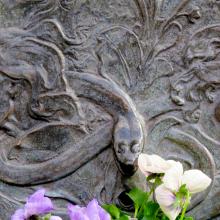
Edinburgh World Heritage is suggesting that a new public statue be raised to commemorate Scottish women put to death as supposed witches.
They say the Castle Esplanade would be a good spot, since only a comparatively inconspicuous memorial exists there now, where 300+ women were burned during the 16th and 17th centuries.
The current art-nouveau fountain (designed by John Duncan RSA and installed in 1894) remembers, without qualification, those put to death as witches:
THIS FOUNTAIN … IS NEAR THE SITE ON WHICH MANY WITCHES WERE BURNED AT THE STAKE. THE WICKED HEAD AND SERENE HEAD SIGNIFY THAT SOME USED THEIR EXCEPTIONAL KNOWLEDGE FOR EVIL PURPOSES WHILE OTHERS WERE MISUNDERSTOOD AND WISHED THEIR KIND NOTHING BUT GOOD. THE SERPENT HAS THE DUAL SIGNIFICANCE OF EVIL AND OF WISDOM. THE FOXGLOVE SPRAY FURTHER EMPHASISES THE DUAL PURPOSE OF MANY COMMON OBJECTS.
In so doing, it implies an intent to practise a craft for good or evil. It does not entertain the possibility that many if not all those burned had no exceptional knowledge, practised nothing substantive whatsoever, and were simply the objects of other people's hysterical projections.


Enough is enough

We think Duncan's monument, with its suggestive and uncomfortable ambivalences, is enough here. It speaks to the complexity of human nature, and anything larger and more figurative would risk being trivial, becoming one more sentimental or ghoulish station on Edinburgh's touristic circuit of past horrors.
However, if some such monument must be erected, then we suggest a better site might be the area formerly known as Multrees Hill. This was (like the former Tollbooth on Broughton Street) long used for ‘witch’ executions.
The advantage of situating a statue here (in a public space at the heart of the soon-to-emerge St James Quarter) would be that, as well as recalling an historical injustice, it could serve as an admonitory counterweight to the dizzying enchantments of today's pre-eminent form of mass hysteria: shopping.
Pointing the finger
Edinburgh World Heritage is partly interested in this discussion as a way of addressing the dearth of women-inspired monuments in the capital.
We raised this embarrassing lack here on 8 March, although a few more monuments have been drawn to our attention since on the Mapping Memorials to Women in Scotland website.
Choosing which figures to prioritise in stone or bronze is of course contentious. Some readers have suggested to Spurtle that it would be better to start with women as doers and achievers rather than as victims.
To this end, perhaps a statue of Lady Leslie Mackenzie (1859–1945) would be in order. Née Helen Spence, she campaigned tirelessly to chart the link between poverty and poor public health; and to redress its effects, particularly among children.
A timely reminder of her life and endeavours might sit very well in today's austerity-hit capital, perhaps outside some frivolous excretion like the Golden Turd, or at the door of that colossus of conspicuous consumption – the proposed Rosewood Hotel on Regent Road.
Controversy tends to deter civic funding and approval for public art, but what is the worth of raising works that merely affirm temporary certainties rather than raising awkward, more enduring public questions?

-----------
Got a view? Tell us at
spurtle@hotmail.co.uk and @theSpurtle and Facebook
-----------------------------------